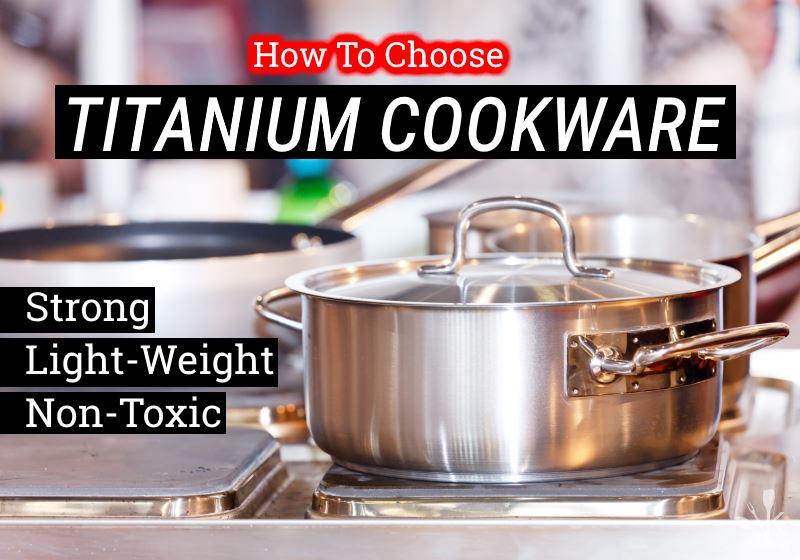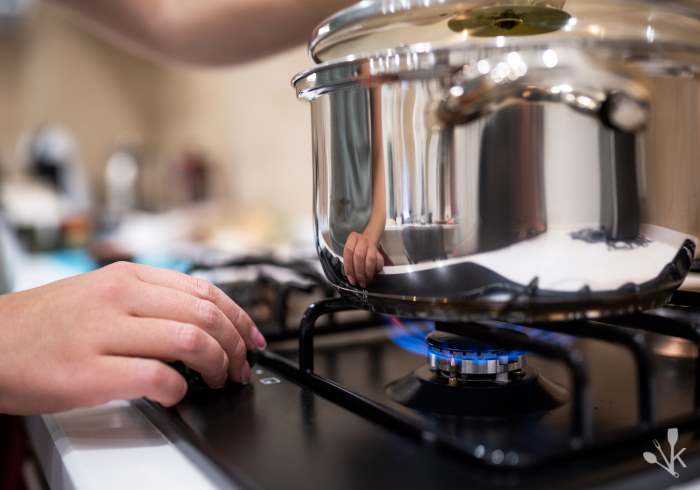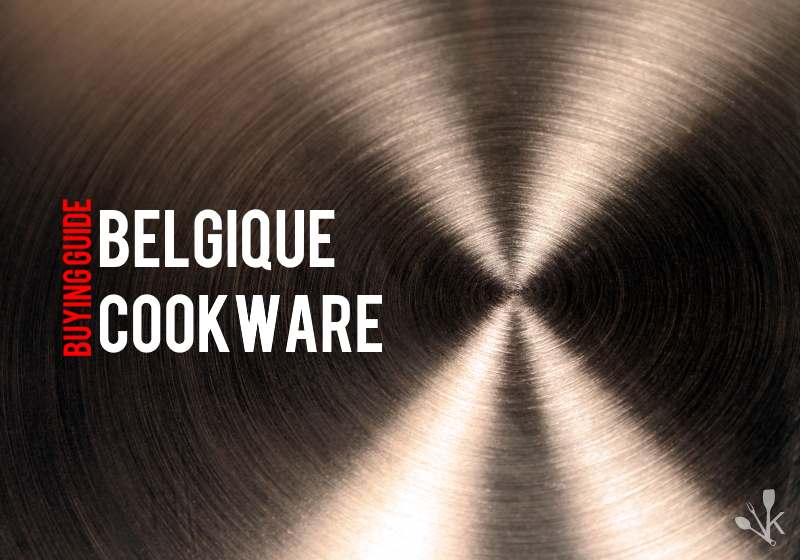Cookware is one of the most important tools in any kitchen, but there are so many options to choose from. So, which type of cookware should you buy? Ceramic or stainless steel?
Ceramic and stainless steel are both great options for cookware, but it comes down to personal preference and how you intend to use them.

Here is a look at the differences between the two and how to decide which type is best for you.
How To Choose Between Ceramic And Stainless Steel Cookware
To give you a quick answer, I’ve laid out some of the key distinctions between ceramic cookware and stainless steel cookware below.

Ceramic cookware is great for quick nonstick cooking but is not as durable as stainless and will scratch easily. While some brands have claimed no issues with acidic foods, it’s best to avoid them when using ceramic-coated cookware.
The best things to cook using ceramic are eggs, bacon, grilled cheese sandwiches, and other foods using low heat sautéing methods. Always avoid using ceramic cookware under a broiler or over a gas stovetop.
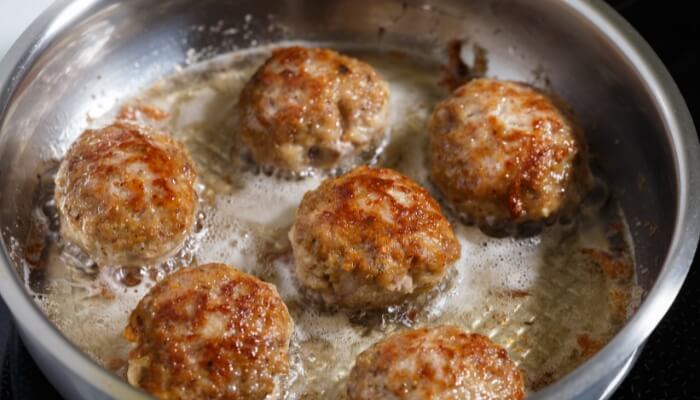
Stainless cookware is better for high-heat cooking can handle metal utensils, and is safer for cooking reactive foods such as lemon and tomato.
Stainless steel is best used for searing meat at high temperatures, boiling water or cooking soups and stews over a long period of time, and making pasta sauce.
Design Differences
Stainless cookware can look pretty much the same overall. It’s silver and sometimes comes with bands of copper, depending on what the brand has done to differentiate it from the rest.
Lids on stainless steel are often all metal, which makes them a little more dangerous to handle when cooking without proper hand protection.
Compared to ceramic, stainless cookware is much heavier. So if you have a weaker arm or wrist, you need to think about the cookware weight and how much it will weigh when you add food to it.
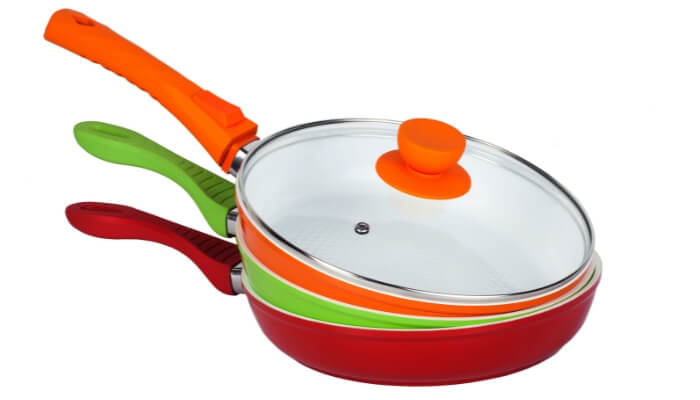
Ceramic cookware comes in all sorts of colors. Even the nonstick coatings range from white to black and orange or gold in the case of Gotham Steel cookware.
Because ceramic cookware has a base of aluminum, it makes it much lighter and easier to handle.
While you may want to have your cookware match your kitchen, it shouldn’t be the biggest factor between the two when deciding.
You also have to consider your stove type. If you’re cooking with induction only, more stainless steel sets will be compatible compared to nonstick cookware.
There are ways to use non-induction cookware with an induction stove, but it’s best to buy the right set to begin with.
Different Safety Concerns (material/items – lids handles)
Safety is an important factor to consider when buying cookware. Both food grade stainless steel and ceramic pots and pans are safe to use. However, there are specific things that you need to look out for.
Ceramic cookware is often made from aluminum cookware that is covered with a nonstick ceramic coating. The ingredients in these coatings vary depending on the brand and are generally not safe for high-heat cooking.
High heat can start to break down the nonstick material, which could end up in your food. But an even more noticeable problem is the lids and handles of ceramic cookware. They are often made with silicone or rubber, and very few brands label them safe for the oven, especially broiling.
Once scratched, the ceramic coating may end up in your food and make it easier for heat to destroy the rest of it.
On the other hand, stainless cookware is often made of all metal, making it safe to use on the stovetop and in the oven. Unless you have a specific metal allergy, you don’t need to worry about metals leeching into your food so long as you buy from any reputable brand.
The key takeaways are to keep your cooking temperatures low with ceramic and avoid scratches to help avoid any potential issues.
You also need to buy from a reputable brand that has all the required certifications. Some off-name brands from other countries don’t have the same standards as the USA and may jeopardize your health when used.
Cooking Differences
As I mentioned earlier, these cookware types cannot be used in the same manner.
Ceramic cookware should not be used for high-heat cooking, such as searing or broiling. In fact, most brands are not oven-safe. However, the nonstick surface makes it much easier to cook with when used at medium-low heat and with a little fat, such as butter.
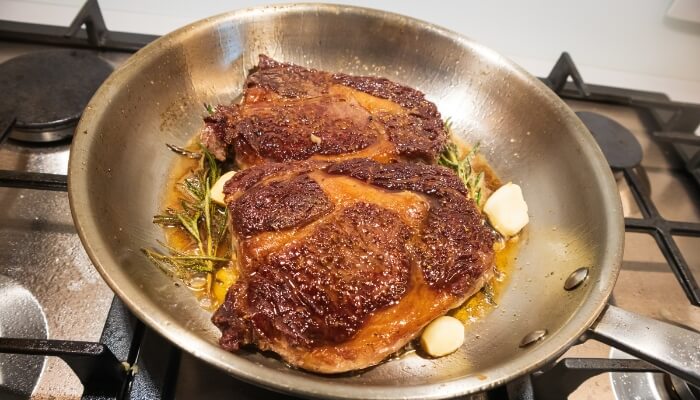
Stainless steel can be used in the oven and is great for searing meat. One of the marketing benefits that you might see is that you can go from stovetop to oven.
The downside is that you will need some practice if you plan to use stainless for nonstick cooking. You’ll need to use more fat for cooking and control the temperature a bit more. You also don’t need to worry as much when cooking reactive foods.
Differences In Durability
Stainless steel is by far more durable than any nonstick coating. You can use metal utensils on it, and scratching is very minimal. Any warping from high heat won’t affect the cookware too much, other than it may not sit correctly over your burner.
Unfortunately, ceramic coatings will scratch when used with metal utensils, despite some brands claiming otherwise. Once a pan scratches, you really should stop using it.
If your ceramic pan starts to warp, not only will it have heating problems, but it will also likely damage the coating. You could end up with flakes of coating your food and simply ruin the nonstick surface.
Differences In Longevity
Again, stainless steel cookware has much more longevity than ceramic. You may often hear of people inheriting stainless cookware from their family, similar to cast iron cookware. When taken care of, it can really last a lifetime.
Ceramic cookware won’t last as long because its coating is damaged easily and degrades over time.
I recommend replacing it after 2 years or sooner if it becomes damaged before then. If it loses its nonstick coating and everything seems to stick no matter what, then it should be replaced to avoid anything leaching into your food.
Which Is Easier To Clean?
When new, ceramic cookware is much easier to clean than stainless steel. However, given time, both can be a nightmare to clean off burnt food.
The more you cook and clean ceramic-coated cookware, the more it will lose the nonstick properties that it had in the beginning. The problem is that when you struggle to clean it well, you use more force scrubbing, which makes the problem worse.
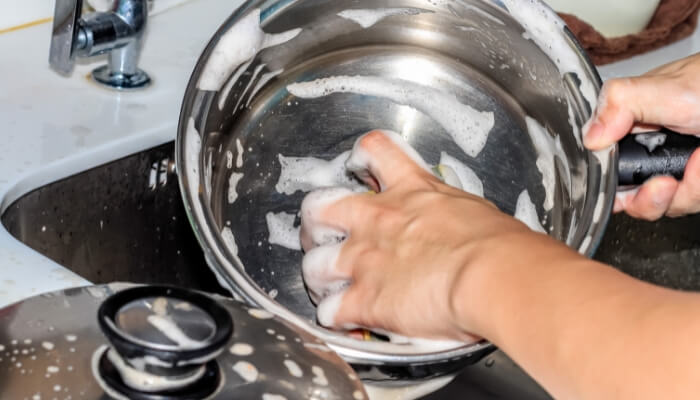
When cleaning stainless steel cookware, you can often deglaze, boil water, or use a scrub pad to help clean stubborn food. With ceramic, you can’t without damaging the coating.
No matter which you choose, it’s important to use enough fats while cooking to help prevent sticking and you should definitely avoid burning food.
Which One Costs More?
A good set of stainless steel cookware will often cost more than ceramic cookware. In fact, some brand name sets can cost 4 or 5 times as much.
However, if you’re buying a good set of stainless steel cookware, the price may be justified just by its durability and longevity.
But if you’re on a budget, and don’t plan to use high heat on the stove or in the oven, then ceramic may be the better buy.
Is Ceramic Better Than Stainless Steel Cookware?
It’s hard to determine if one is better than the other because there are many factors to consider. They both have pros and cons, but to sum up, I have the following advice.
Learn how to cook and clean stainless steel cookware. It’s fairly easy to take care of, and with proper cleaning, it can be shined up to look new again, year after year. Use it for everything except for foods that are prone to sticking, such as eggs.
Buy a ceramic pan dedicated to your eggs and other nonstick cooking needs. It will be a little bit easier to use and easier on the budget over the long term, and if you end up not liking it, you can easily get rid of it and find something better.

